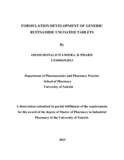| dc.contributor.author | Ososo, Ronald W | |
| dc.date.accessioned | 2016-04-28T14:08:16Z | |
| dc.date.available | 2016-04-28T14:08:16Z | |
| dc.date.issued | 2015 | |
| dc.identifier.uri | http://hdl.handle.net/11295/95294 | |
| dc.description.abstract | Introduction
The Lennox-Gastaut syndrome (LGS) is a rare and one of the most severe forms of childhood epilepsy syndrome. The syndrome usually affects children between the ages of 1 and 8 years (typically between 3 and 5 years), but occasionally has its onset in children who are more than 8 years old. A small proportion of the East African population has been found to suffer from poor management of this disease. The disease is usually treated with multiple drug therapy and currently there is no optimal drug combination to manage it effectively. Rufinamide has been found to lead to 50 % reduction in seizure episodes among LGS patients when used as an adjunct therapy in the management of LGS with other Anti-Epileptic Drugs (AEDs). The innovator brand is under patent protection in the United States, Europe and major pharmaceutical markets and therefore the benefit of using Rufinamide, considered an orphan drug, is not available to patients in East Africa. This research project therefore aims to formulate generic Rufinamide tablets that can be scaled up at industry level for use by the East African population that suffers from this condition.
Methodology
Four formulation batches (F1, F2, F3 and F4) with an average tablet weight of 600 mg were developed. F1 comprised of rufinamide, mannitol, hydroxy propyl methyl cellulose (HPMC), lactose monohydrate, maize starch, sodium lauryl sulfate (SLS), sodium carboxy methyl cellulose, anhydrous colloidal silica and magnesium stearate while F2, F3 and F4 had the same composition as F1 but in F2 HPMC was replaced with microcrystalline cellulose intragranularly whereas F3 had the MCC extra granularly. F4 contained both hydroxyl propyl methyl cellulose and microcrystalline cellulose in equal proportions. Wet granulation process with distilled water as the granulating fluid was used and tablet compression was performed using a single punch tablet press (Inweka, India). The tablets were then assessed for quality as per the BP and USP monographs.
Results and Discussion
Microcrystalline cellulose shortened the disintegration times of F2 and F3 while its mode of incorporation (intra or extra granular) had a negligible effect on disintegration and dissolution rate since F2 and F3 had comparable disintegration times, 2.7 and 2.4 minutes respectively. F4
xii
contained half the amount of MCC that was contained in either of F2 or F3 and disintegrated in 11.4 minutes but gave a higher drug release profile than the others. F1 did not contain MCC and required the longest time of 95 minutes to disintegrate.
Conclusion
F2 and F3 were similar to brand as shown by the f2 values of 61.6 and 58.9 respectively while F4 was different (f2 = 40.8) but had the highest dissolution profile.
Hence F4 can be developed further by establishing a suitable combination ratio of MCC and HPMC to improve both disintegration and dissolution. | en_US |
| dc.language.iso | en | en_US |
| dc.publisher | University of Nairobi | en_US |
| dc.rights | Attribution-NonCommercial-NoDerivs 3.0 United States | * |
| dc.rights.uri | http://creativecommons.org/licenses/by-nc-nd/3.0/us/ | * |
| dc.title | Formulation development of generic rufinamide uncoated Tablets | en_US |
| dc.type | Thesis | en_US |
| dc.description.department | a
Department of Psychiatry, University of Nairobi, ; bDepartment of Mental Health, School of Medicine,
Moi University, Eldoret, Kenya | |



